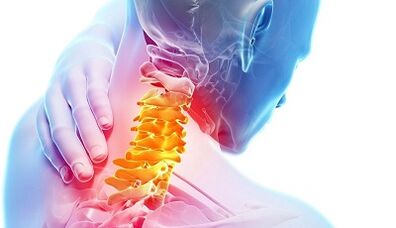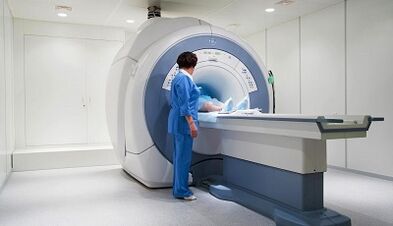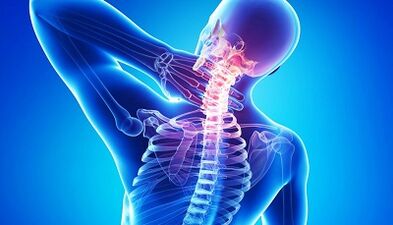Among all the violations of the musculoskeletal system, second place in terms of prevalence is occupied by osteochondrosis of the cervical column.Symptoms and the treatment of the disease are determined at the stage of its development, so it is so important not to miss the signs of an imminent disease.
Causes and symptoms of osteochondrosis of the cervical column

Osteochondrosis is called dystrophic changes in joint cartilage in the bottom of the intervertebral disc lesion.
Cervical osteochondosis is characterized by the pathological destruction of the cartilage tissue of the vertebrae which support the head.
Most often, the disease is diagnosed in people aged 30 to 40.In developed countries, this degree or another degree of cervical osteochondosis is diagnosed in 80% of the population.
The neck is considered the most mobile spine.At the same time, there is an insufficient quantity of muscles around the neck which can compensate for the loads on the spine.Consequently, most of the charges falls on the intervertebral discs which play the role of the absorption of shocks.
Consequently, the discs wear out, dry and steal, osteochondosis develops.
The reasons contributing to the appearance of pathology reside not only in anatomy, but also in human behavior:
- Soweity and static and sedentary work - to the computer, leading a car, to the office;
- Excess weight;
- Great physical effort;
- smoking;
- bad nutrition;
- weak physical form;
- Injuries of the spine.
The additional provocative factors in the development of osteochondrosis are: flat feet, soft mattresses and pillows, the habit of carrying a bag on the shoulder, hypothermia and stress.
How the disease manifests itself
At the start of the disease on its development, only the flow of the neck, which is generally not paid attention.With the progress of pathology, the number and intensity of manifestations increase.
The characteristic symptoms of cervical osteochondosis occur:
- Pain at the back of the head, at the base of the neck, giving in the limbs;
- Crunch and pain during the shooting of the head;
- numbness or tingling of the areas between the shoulder blades and at the base of the neck, burning, a feeling of discomfort and stiffness;
- Headache, migraines, dizziness;
- Weakness, fatigue.
Secondary symptoms are considered to be a decrease in vision, hearing, memory problems, sleep disorders, inattention, distraction, pressure.
Syndromes caused by osteochondrosis of the cervical column

Doctors classify signs of osteochondrial processes as syndromes associated with a certain type of spine.
Stenosis.It develops in the context of the hernia of intervertebral discs and is accompanied by a violation of blood circulation and the growth of bone tissue.It manifests itself by numbness of the members.
Reflex and irrititive syndrome- A consequence of the compression of the vertebral artery with the curvature of the neck and the altered posture.It manifests itself in severe paroxysmal pain in the occipital part with a progressive propagation in the areas around the front.
Rook syndrome.It is observed during the flattening of vertebral roots - the consequences of a hernia.At the same time, sensitivity in affected areas is reduced and motor activity becomes limited.It can be accompanied by the development of speech defects, snoring, altered smell, a decrease in the sensitivity of language muscles.
The degree of development of cervical osteochondosis
The complexity of the process process is determined by the state of the pulpose nucleus which fills the vertebral space.
The degenerative lesions of the cervical region are conditionally divided into three stages:
- First of all.The intervertebral disc is compacted.The hooks of the vertebrae of the vertebrae increase.The stiffness of the muscles appears, but their mobility does not change.Small edema and pain during the turn of the head are possible;
- The second.It develops in the context of the progression of the first stage of the disease, if the treatment of osteochondrosis of the cervical column was absent or incorrectly performed.The intervertebral holes are narrowed, the height of the intervertebral discs becomes less because of their flattening.Pliers the nerve roots.The patient feels painful pain;
- The third.The cracks in the fibrous ring surrounding the intervertebral disc lead to the rupture of its capsule and to the deformation of the muscle tissue.The stability of the pulp nucleus fixing inside the intervertebral disc is raped.An intervertebral hernia is developing.It is characterized by acute pain in the neck, numbness of the tongue, edema, limitation of mobility, a curvature of the spine.
The correct position of the vertebrae of the cervical region determines the functionality of the visual and auditory nerves, the nose, the lips, the mouth, the throat, the teeth, the facial nerve, the pituitary gland, the brain, the parasympathetic nervous system, the neck muscles and the forearm, the thyroid glans, the elbows and the shoulder joints.
Diagnostic methods

The exact determination of the cause of the development of osteochondrosis allows you to deliberately affect the disease.The preliminary diagnosis is indicated after the initial exam by the doctor.
Patient complaints concerning the nature of pain syndromes are taken into account, as well as the information obtained during the spine examination in various positions.The study of the cervical compartment allows you to determine the presence of seals and deformations.In addition, attention is paid to the tone of the patient's muscles and motor skills.
Doctors receive full diagnostic information using studies such as:
- X -ray.The procedure allows you to assess the condition of the vertebrae in two projections - right and lateral.The result is the determination of damage, saline deposits and compacted training;
- Magnetic resonance tomographyAllows you to establish not only all pathologies in the spine, but also the degree of severity.By means of an MRI, a doctor can assess the condition and the level of damage to nerve endings, blood vessels and intervertebral discs;
- Computed tomography- Digitization of information obtained by irradiation of X -rays.
In the presence of dizziness, an additional study of the structural change of the blood vessels by domorography, angiography and duplex scanning may be necessary.
How to treat cervical osteochondrosis?
After making a precise and clarified diagnosis the causes of the development of the disease, the neurologist determines how to treat cervical osteochondosis.
The optimal results are provided by complex therapy, which provides for the use of several methods.Protocols include the effects of drugs, material procedures, exercise therapy and therapeutic massage.
Treatment with drugs

In each individual case, the choice of drugs occurs individually.It depends not only on the severity of the pathology, but also on the specific characteristics of the patient's body.
Fixed drug treatment drugs:
- Anti -inflammatory drugs - tablets that relieve pain and inflammation;
- Chondroprotectors - Medicines that activate the regeneration of cartilage fabric;
- External use - ointments and gels that stop pain and inflammation;
- A complex of vitamins to support the body and stimulate its restoration.
At the first stage of the therapeutic effect, it is possible to increase pain syndrome - it is the reaction of the muscle system.To reduce discomfort and improve drug treatment results, physiotherapeutic procedures are used.
Physiotherapy
Physiotherapy means the effect on the cause of the disease using special equipment - electrophoresis, tissue electrical stimulation.The use of low -frequency currents improves blood circulation in affected areas, relieves edema and pain and at the same time increases the effectiveness of medical effects.
The minimum course of material treatment is 10 sessions.
Massage for cervical osteochondrosis at home
Manual therapy is a productive means of influencing the affected areas at home.Using massage, pinching, muscle cramps and pain are eliminated, blood circulation improves and the compression of the nerve roots is reduced.
Thanks to massage, the metabolism improves and the tissues of the spine are restored.
Media physical education for osteochondrosis of the cervical column
The best method of restoring the functionality of the organs of the musculoskeletal system and the prevention of relapse is the physical education of physiotherapy for osteochondrosis in the cervical region.Procedures are prescribed after completely relief of pain and inflammatory processes.
The main types of exercise therapy:
- Medical gymnastics;
- dosed march;
- classes on simulators;
- swimming.
In order for the exercises for cervical osteochondosis to bring the expected results, the classes must be maintained under the supervision of competent specialists.
Folk remedies
Complete elimination of cervical osteochondosis using traditional medicine methods is impossible.On the other hand, the use of folk remedies allows you to improve the patient's condition, relieve inflammation, reduce pain and strengthen immunity.
On average, the therapeutic period with cervical osteochondosis takes up to three months.If a conservative treatment has not brought the expected results, surgery is used.
Why is cervical osteochondosis dangerous?

Neck pathologies are a serious threat to human health.Since the neck connects the head to the body, in this section of the spine, there are all important organic communications - arteries that feed the brain, the nervous canals.
Any change in the functionality of the cervical region implies the consequences in the form:
- Blood circulation and brain nutrition disorders.Consequently, hypertension, the pathology of the respiratory system and the cardiovascular system, the VSD, altered coordination, problems with hearing, vision and speech develop;
- Vertebrate artery syndrome.Pathology develops in the context of pressing a vessel that feeds the cerebellum and an oblong brain.The development of cervical osteochondosis can cause ischemia and stroke;
- Radiculopathy - damage to nerve roots, growth of bone tissue on the vertebrae, as a result of which partial or complete mobility loss occurs.
The most dangerous compression of the spinal cord, which is located inside the spine.Such a pathology leads to a break in the shell of the spinal cord and causes paralysis.In particularly serious cases, cervical osteochondosis ends deadly.
Prevention
Even after a complete recovery, the disease can come back if the patient does not revise his lifestyle - work mode and rest, habits, food.
As preventive measures, neurologists recommend paying attention to the following points:
- The rigidity of the mattress.The ideal option is an orthopedic mattress and a low pillow;
- A visit to the sauna is necessary for complete relaxation and elimination of muscle cramps;
- The daily hot shower is a good tool for improving blood circulation in the neck;
- Swimming, walking, stimulates blood circulation, strengthens the muscles of the spine;
- Good nutrition is the rejection of products that slow down metabolism: fat, fried, sweet, smoked, flour and alcohol.Dishes with gelatin, dairy products, nuts, vegetables, white meat, seafood are recommended.

In everyday life, great physical effort must be avoided, clear turns of the head, a prolonged seat or a static position.In addition, it is desirable to use chairs that support the head and back.
The position of active life, healthy foods and morning exercises are simple but effective means of avoiding most diseases and living a long life without pain or discomfort.


















